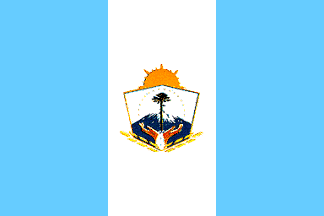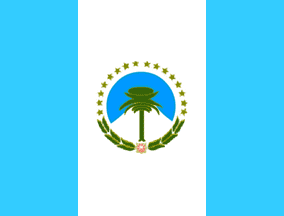
Last modified: 2020-07-26 by francisco gregoric
Keywords: neuquén | provincia del neuquén | error | volcano | lanin | pehuen | araucaria araucana | tree: monkey puzzle | star: 8 points (red) | stars: 17 | stars: arc | star: 5 points (golden) | mástice (mario aldo) |
Links: FOTW homepage |
search |
disclaimer and copyright |
write us |
mirrors
![[flag of Neuquen]](../images/a/ar-neu.gif)
The flag of Neuquen has three equal vertical stripes blue, white, blue. In the center, a badge made from elements of the provincial coat of arms. The same person (Mario Aldo Mástice) designed both the flag and the coat of arms. The badge in the center of the flag consists of a blue disc charged with the volcano Lanín and superimping the volcano, a pehuen (monkey puzzle tree, Araucaria araucana) in front of it. Around the disc, laurel branches joined at the bottom by a poincieta, or federal star (estrella federal), a local flower.
Gustavo Tracchia, 23 Feb 2000
The 16 yellow stars around the central symbol stand for the 16 departments (subdivisions) of the Province. On indoors ceremonial flags the stars are sometimes golden.
Francisco Gregoric, 6 Mar 2008
On October 31, 1989 the flag of Neuquén was adopted by Law No. 1817. The text of the law is the following (first in Spanish, then translated to English):
![[flag of Neuquen]](../images/a/ar-neu!b.gif)
The color of the provincial flag is just defined as "sky blue" by law. The usual color used is the same one than the color of the national flag. However, flags of Neuquén with a darker shade of blue appear sometimes.
Francisco Gregoric, 6 Mar 2008
![[flag of Neuquen]](../images/a/ar-neu_o.gif)
Ornato flag is a flag for decorative purposes.
Jaume Ollé, 31 Aug 2000
The Bandera de ornato (ornament flag) is defined in Argentina as a flag usually used for ornamentation of schools during patriotic celebrations and commemorations. It is usually hung in balconies as a patriotic decoration, but rarely seen in a flagstaff.
In the case of the Argentine national flag, a plain triband without sun is used as ornament flag. In the case of the provincial flag of Neuquén a plain vertical triband is used as ornato flag. These ornato flags can never be raised over the normal national or provincial flags.
Francisco Gregoric, 6 Mar 2008
![[flag of Neuquen]](../images/a/ar-neu!o.gif)
As the normal provincial flag, the Bandera de ornato also appears sometimes in a darker shade of blue.
Francisco Gregoric, 6 Mar 2008

This image is not correct. The Neuquen’s flag is certainly blue -
white - blue vertical, but the central emblem is not the arms of the
province, depicted in this image, but a stylized version in green and
gold, including 16 golden stars in semi-circle. Also proportions should
be c. 4:5 instead of the used 2:3.
Mario Fabretto and
Jaume Ollé, 10 Dec 1998

At the official website there is a
flash
presentation including the flag.
Dov Gutterman, 13 Dec 2001
The image at the provincial website, coming from the province government,
should be best, though it is not. Neither technically, but is also
shows design differences comparing with Jaume’s image above
— the width of the blue stripes, it’s shade respective to
the national flag and to the sky on the emblem, and
design details of the emblem itself. Official websites
presenting incorrect
versions of their symbols is hardely seldom, but noteworthy even so.
António Martins, 14 Dec 2001
!.gif)
![[Province of Neuquén coat of arms]](../misc/ar)q.gif)
The provincial coat of arms of Neuquén was adopted by Law No.16 on September 10, 1958. It was designed by Mario Aldo Mástice, the same designer of the provincial flag.
According to Mr. Mástice explanation, its shape is the feeling of the century, the advacement and exceeding.
The laurels and the sun that are part of the national coat of arms, stand for glory and freedom inheritatad from the ancestors. The sky blue and white colors are testimony of being Argentine.
The Lanín Volcano and the Pehuén Tree are indigenous symbols of the Province of Neuquén.
The hands are an offer thanking the gifts of nature.
The 16 stars stand for the 16 departments (subdivisions of the province).
Between the hands a mountain river appears. It is similar to the Limay and Neuquén rivers of the province (the latter one gave its name to the whole province).
Francisco Gregoric, 6 Mar 2008
Anything below this line was not added by the editor of this page.